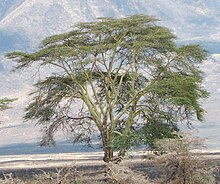Fevertree
| Fever tree | |
|---|---|
 |
|
| Scientific classification | |
| Kingdom: | Plantae |
| Clade: | Angiosperms |
| Clade: | Eudicots |
| Clade: | Rosids |
| Order: | Fabales |
| Family: | Fabaceae |
| Clade: | Mimosoideae |
| Genus: | Vachellia |
| Species: | V. xanthophloea |
| Binomial name | |
|
Vachellia xanthophloea (Benth.) P.J.H.Hurter |
|
| Synonyms | |
|
Acacia xanthophloea Benth. |
|
Acacia xanthophloea Benth.
Vachellia xanthophloea is a tree in the Fabaceae family and is commonly known in English as the fever tree (local East African names include olerai, kimwea, murera, and mwelele). This species of Vachellia is native to eastern and southern Africa. It can be found in Botswana, Kenya, Malawi, Mozambique, Somalia, South Africa, Swaziland, Tanzania, Zambia and Zimbabwe. It has also become a landscape tree in other warm climates, outside of its natural range.
The trees grow to a height of 15–25 m (49–82 ft). The characteristic bark is smooth, powdery and greenish yellow, although new twigs are purple, flaking later to reveal the characteristic yellow. It is one of the few trees where photosynthesis takes place in the bark. Straight, white spines grow from the branch nodes in pairs. The leaves are twice compound, with small leaflets (8 mm × 2 mm (0.3 in × 0.1 in)). The flowers are produced in scented pale cream spherical inflorescences, clustered at the nodes and towards the ends of the branches. The pale brown pods contain 5-10 elliptical, flattened green seeds and are 5–19 cm (2.0–7.5 in) long, straight, flat and rather papery, the segments are mostly longer than they are wide, often breaking up to form small clusters of segments each containing an individual seed. As the pods mature they change colour from green to pale greyish brown.
Fever trees are fast growing and short lived. They have a tendency to occur as single-aged stands, and are subject to stand-level diebacks that have been variously attributed to elephants, water tables, and synchronous senescence.
The name xanthophloea is derived from Greek and means "yellow bark" (ξανθός "yellow, golden"; φλοιός "bark"). The common name, fever tree, comes from its tendency to grow in swampy areas: early European settlers in the region noted that malarial fever was contracted in areas with these trees. It is now understood that malarial fever is spread by mosquitos living in the swampy areas that often support this tree species, and not by the tree species itself.
...
Wikipedia
